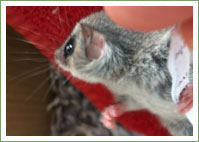Eastern Pygmy-possum rescued by school students
Tuesday, February 14, 2012
Update 23rd February: The young Eastern Pygmy-possum is doing really well. He has been gaining weight, eating voraciously and according to his carer, Lyn he is very feisty, which is an achievment when you weigh only 16 grams!
Some students at a school in the northern beaches area of Sydney found a small creature on the ground under some leaves in their school grounds. It was tiny and they thought it may have been a feathertail glider.
They acted quickly and took the tiny animal to the office where an improvised nest was made and a call put through to WIRES.
The tiny mammal has been identified as an Eastern Pygmy-possum, listed as vulnerable in the Sydney metropolitan area and our records show only two or three have been rescued by WIRES in the Sydney area.
He weighed only 6 grams when found and is estimated to be only a little over a month old. He has had some ticks removed and has already gained one whole gram! He will need to gain another 10 grams before he can be released.
Eastern Pygmy-possums are generally nocturnal and appear to be mainly solitary. They are good climbers and in winter frequently spend time in torpor, where they curl their body, fold their ears and maintain their internal temperature in line with their surroundings.
We hope when he is ready for release he can go back to the Belrose area where he was found.
Our thanks to the students and staff of Covenant Christian School for calling WIRES so quickly and for caring about our wildlife.

Recent Posts
WIRES launches its first wildlife rehabilitation centre - Mullyang
WIRES Emergency Response in the wake of ex-tropical cyclone Alfred
International Women’s Day Volunteer Spotlight: Shelley
Tropical Cyclone Alfred – Emergency Wildlife Advice
Interview with WIRES Training and Development
Celebrating Women in Science: The Journey of Holly, Wildlife Conservationist and WIRES Team Member
